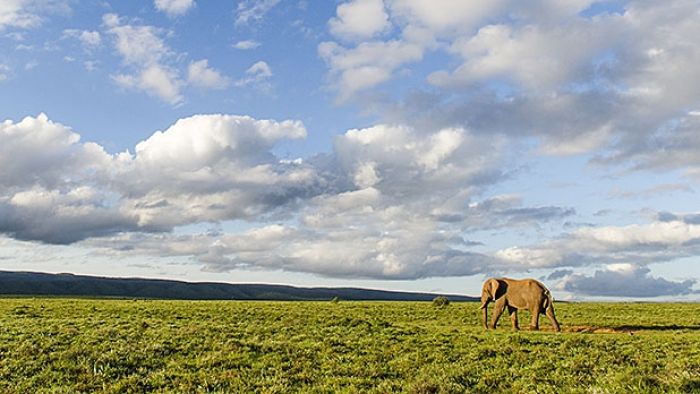DIY African Safari, for $75 a Day
You don't have to break the bank to see a bull walking across the grasslands in Addo Elephant National Park.
Credit: Peter Chadwick / Getty Images
An affordable African safari? What's the point? Yes, cost-cutting for a trip of a lifetime — and one that includes giant animals that can kill you — is something that rarely crosses the mind of any trip-planners. But that shouldn't be the case. If you're willing to give up over-the-top luxury tents and four-course meals, you can still safely and easily navigate yourself around the hippos, rhinos, and, yes, lions in the wild.
The trick is to travel the way South African's do: Rent a car (from $25 a day), head to one of the country's numerous public wildlife parks (less than $20 a day admission), and stay in park accommodations (as little $50 a night including breakfast and the occasional hippo in the yard).
It's that easy. We tested our plan in Addo Elephant National Park recently, renting a car and heading out to see elephants. Our first major wildlife encounter came less than ten minutes after driving through the gates. A young bull was heading south on the road we were traveling north on. In pachyderm versus automobile rules of the road, this meant we hightailed it in reverse until the elephant found another path. By lunchtime, we'd sighted our way through a nursery-school-rhyme of wild animals: we dodged Cape buffalo, ogled a giraffe when she peaked inside our car, and had a too-close encounter with a pair of white rhinos.
ALSO: The 18 Most Remote Luxury Camps in the World
In South Africa, the thriftiest (or most adventurous) visitors camp in tents in the wildlife parks. But we opted for a real bed and actual walls between us and the country's big five (lion, leopard, elephant, buffalo, and rhino). If you're going it alone, be sure to shake down your local ranger for day-to-day advice — where to go, weather alerts, and if anything is awry in the borders. Otherwise, follow the advice here to go it alone without a worry.
Go public.There are dozens of public wildlife parks in South Africa — ranging from well known national parks such as Kruger to expansive, and blissfully uncrowded, provincial parks. The best deals in accommodation (the entry fees are similar) are sometimes found at smaller national parks like Addo Elephant National Park or Ezemvelo KZN Wildlife Parks like Hluhluwe Imfolozi.
Drive yourself.While you may have pictured yourself traversing the veldt with a khaki-clad tracker at the wheel of your jeep — you'll find the same animals by exploring the park's side roads in your own rental car (use the free map and guidebook you get with your entry ticket). If you miss an animal or two, you can always cap off your week with a guided game drive.
Embrace the braai.The BBQ (braai) has an elevated status in South Africa, and while you could frequent the restaurants, even the most modest park lodging comes with a braai area and shared kitchen space. While it may seem cheeky, many grocery stores sell wild game meats such as kudu or antelope — so you can also sample whatever you spot.
Stay in the car.It's illegal to get out of your car in the parks — unless in an area where it's expressly permitted. This isn't just to keep you from being eaten; it also helps prevent the animals from getting habituated to humans. And as tempting as it might seem, don't clap or mimic an animal's sound in the hope of getting their attention for the perfect picture — there's always a chance you'll trigger a charge.
Get the latest in gear, fitness, travel & more delivered directly to your inbox. Sign up now for the Men’s Journal newsletter.
